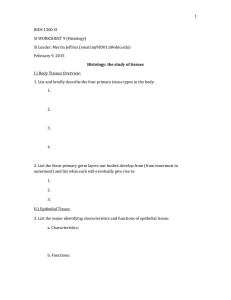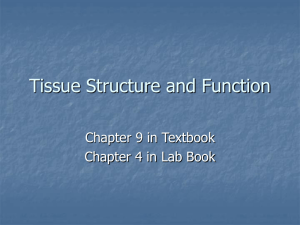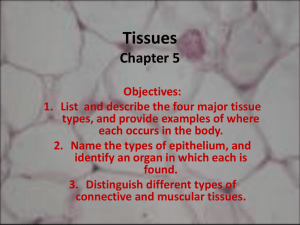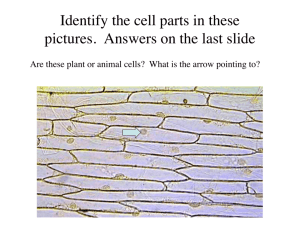simple cuboidal epithelium
advertisement
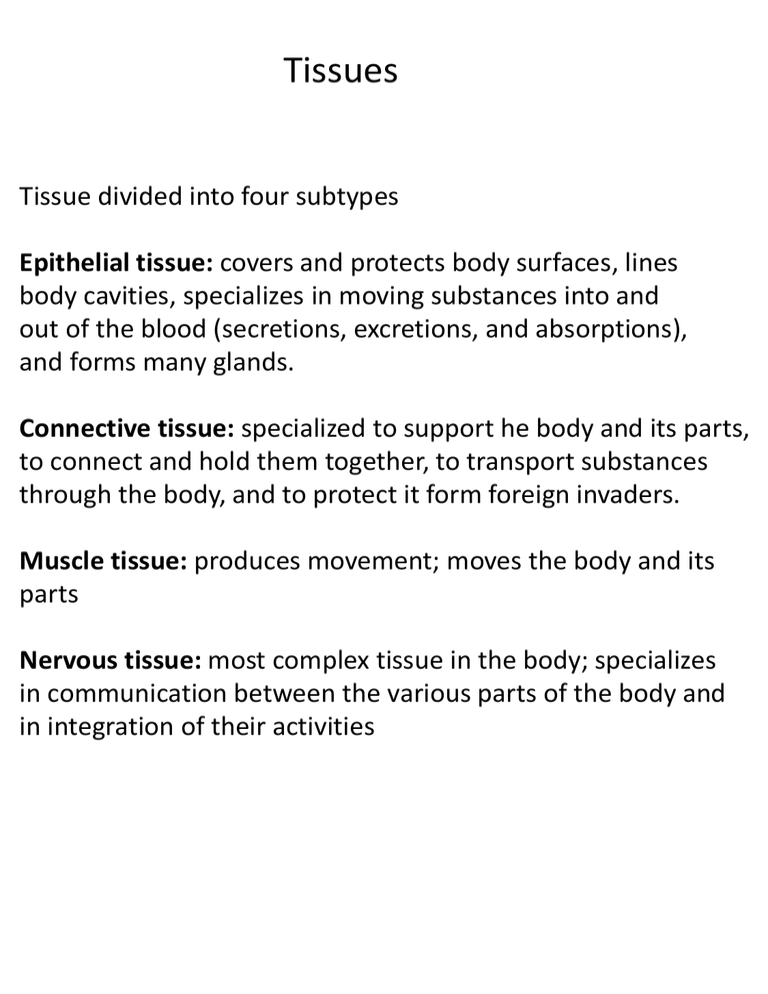
Tissues Tissue divided into four subtypes Epithelial tissue: covers and protects body surfaces, lines body cavities, specializes in moving substances into and out of the blood (secretions, excretions, and absorptions), and forms many glands. Connective tissue: specialized to support he body and its parts, to connect and hold them together, to transport substances through the body, and to protect it form foreign invaders. Muscle tissue: produces movement; moves the body and its parts Nervous tissue: most complex tissue in the body; specializes in communication between the various parts of the body and in integration of their activities Types and locations of epithelial tissue Subdivided into two types Membranous (covering or lining) epithelium: cover the body and some of its parts, and some line the serous cavities (pleural, pericardial, and peritoneal ), the blood and lymphatic vessels, and the respiratory, digestive, and genitourinary urinary tracts Glandular epithelium: grouped in solid cords or specializes follicles that form the secretory units of endocrine and exocrine glands Functions of epithelial tissue Protection: most important function; relatively tough and impermeable covering of the skin-protects body from mechanical and chemical injury and from invading bacteria and other disease-causing microorganisms Sensory: specialized for sensory functions found in the skin, nose, eye, and ear. Secretion: includes hormones, mucus, digestive juices, sweat Absorption: lining of the gut, respiratory tract allows for the absorption of nutrients from the gut and the exchange of respiratory gases between air in the lungs and the blood Excretion: lining of kidney tubules makes the excretion and concentration of excretory products of excretory products in the urine possible. Generalizations about epithelial tissue Attaches to an underlying layer of connective tissue by means of a thin non-cellular layer of adhesive, permeable material called the basement membrane Contains no blood vessels (avasular), oxygen and nutrients Diffuse from capillaries in the underlying connective tissue Through the permeable basement to reach living cells Endure considerable wear and tear, frequently go through cell division in many locations, new cells replace old or destroyed cells in the skin or in the lining of gut or respiratory tract. Classifications of epithelial tissue Classifications of tissue named by number of layers and shape of cells that make up the cell Shape of membranous epithelial tissue cells may be used for classification purposes Four cell shapes 1. Squamous cells: are flat and plate like. 2. Cuboidal cells: are cube-shaped. 3. Columnar cells: higher than they are wide and appear narrow and cylindrical 4. Pseudostratified columnar: only one layer of oddly shaped columnar cells . Touches the basement membrane, tops of some do not fully extend to the surface of the membrane. Some of the nuclei are near the top and some near the bottom. Classifications based on layers of cells Simple epithelium: cells in a single layers Stratified epithelium: cells are layered one on another Squamous cell Flat and platelike SIMPLE SQUAMOUS EPITHELIUM This picture shows the lining of an artery, one location for this type of tissue. SIMPLE CUBOIDAL EPITHELIUM Simple cuboidal epithelium Cuboidal epithelium is found in glands and in the lining of the kidney tubules as well as in the ducts of the glands. SIMPLE COLUMNAR EPITHELIUM These cells line your respiratory and digestive tracts. CILIATED COLUMNAR EPITHELIUM Ciliated columnar epithelial cells are found mainly in the tracheal and bronchial regions of the pulmonary system and also in the fallopian tubes of the female reproductive system. CILIATED SQUAMUS EPITHELIUM CILIATED SQUAMUS EPITHELIUM PSEUDOSTRATIFIED COLUMNAR EPITHELIUM Cuboidal Cells Columnar cells Pseudostratified columnar epithelium Simple Squamous Epithelium Simple cuboidal epithelium Simple columnar epithelium Simple columnar epithelium Pseudostratified columnar epithelium Stratified Squamous Epithelium Stratified cuboidal epithelium Stratified Columnar Epithelium Apocrine Gland Holocrine Gland Merocrine Gland


